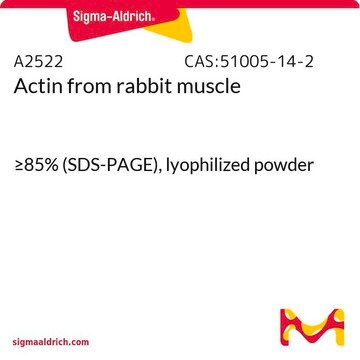A4700
Monoclonal Anti-Actin antibody produced in mouse
clone AC-40, ascites fluid
Synonyme(s) :
Monoclonal Anti-Actin
About This Item
Produits recommandés
Source biologique
mouse
Niveau de qualité
Conjugué
unconjugated
Forme d'anticorps
ascites fluid
Type de produit anticorps
primary antibodies
Clone
AC-40, monoclonal
Poids mol.
antigen 42 kDa
Contient
15 mM sodium azide
Espèces réactives
human, Xenopus, hamster, mouse, guinea pig, rat, rabbit, snail, sheep, canine, carp, chicken, pig, bovine, viper, goat
Technique(s)
immunohistochemistry (frozen sections): suitable using methanol-fixed, frozen sections
indirect ELISA: suitable
indirect immunofluorescence: 1:200 using cultured human or chicken fibroblasts
western blot: 1:500 using cultured human or chicken fibroblast extract
Isotype
IgG2a
Conditions d'expédition
dry ice
Température de stockage
−20°C
Modification post-traductionnelle de la cible
unmodified
Informations sur le gène
human ... ACTA1(58) , ACTA1(58) , ACTA1(58) , ACTA2(59) , ACTA2(59) , ACTA2(59) , ACTB(60) , ACTB(60) , ACTB(60) , ACTC1(70) , ACTC1(70) , ACTC1(70) , ACTG1(71) , ACTG1(71) , ACTG1(71) , ACTG2(72) , ACTG2(72) , ACTG2(72)
mouse ... Acta1(11459) , Acta1(11459) , Acta1(11459) , Acta2(11475) , Acta2(11475) , Acta2(11475) , Actb(11461) , Actb(11461) , Actb(11461) , Actc1(11464) , Actc1(11464) , Actc1(11464) , Actg1(11465) , Actg1(11465) , Actg1(11465) , Actg2(11468) , Actg2(11468) , Actg2(11468)
rat ... Acta1(29437) , Acta1(29437) , Acta1(29437) , Acta2(81633) , Acta2(81633) , Acta2(81633) , Actb(81822) , Actb(81822) , Actb(81822) , Actc1(29275) , Actc1(29275) , Actc1(29275) , Actg1(287876) , Actg1(287876) , Actg1(287876) , Actg2(25365) , Actg2(25365) , Actg2(25365)
Vous recherchez des produits similaires ? Visite Guide de comparaison des produits
Description générale
The antibody recognizes an epitope located on the C-terminal end of actin conserved in all actin isoforms. It specifically labels actin in a wide variety of tissues and species. The epitope recognized by the antibody is resistant to formalin-fixation and paraffin-embedding. Zinc-formalin, B5, ethanol, methacarn, Brunnel′s or Bouin′s solutions may also be used as fixatives.
Monoclonal Anti-Actin (mouse IgG2a isotype) is derived from the AC-40 hybridoma produced by the fusion of mouse myeloma cells and splenocytes from an immunized mouse. A synthetic actin C-terminal peptide attached to Multiple Antigen Peptide (MAP) backbone was used as the immunogen. The isotype is determined using Mouse Monoclonal Antibody Isotyping Reagents, Catalog No. ISO2.
Spécificité
Immunogène
Application
- in the detection of actin in HeLa cells, breast cancer cell line and leukemia cell line using western blotting
- in human fibroblasts by immunofluorescence detection
Actions biochimiques/physiologiques
The actin in cells of various species and tissues are very similar in their immunological and physical properties characterized by electrophoresis and amino acid sequence analysis.(from bulletin) They mediate cytoskeletal remodeling during T cell activation. Mutation in the γ-actin and β-actin gene is associated with a developmental disorder called Baraitser-Winter syndrome. Mutation in the γ-actin leads to hearing loss.
Forme physique
Stockage et stabilité
Autres remarques
Clause de non-responsabilité
Not finding the right product?
Try our Outil de sélection de produits.
En option
Code de la classe de stockage
11 - Combustible Solids
Classe de danger pour l'eau (WGK)
WGK 1
Certificats d'analyse (COA)
Recherchez un Certificats d'analyse (COA) en saisissant le numéro de lot du produit. Les numéros de lot figurent sur l'étiquette du produit après les mots "Lot" ou "Batch".
Déjà en possession de ce produit ?
Retrouvez la documentation relative aux produits que vous avez récemment achetés dans la Bibliothèque de documents.
Les clients ont également consulté
Notre équipe de scientifiques dispose d'une expérience dans tous les secteurs de la recherche, notamment en sciences de la vie, science des matériaux, synthèse chimique, chromatographie, analyse et dans de nombreux autres domaines..
Contacter notre Service technique















